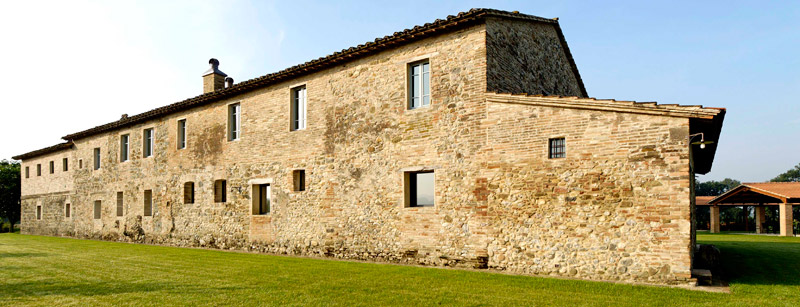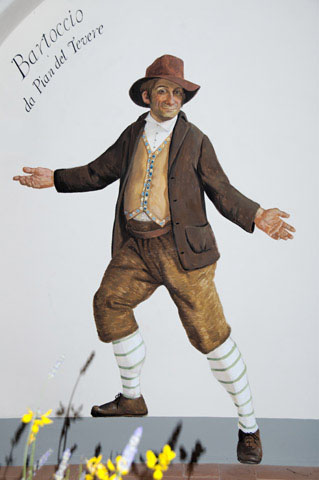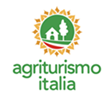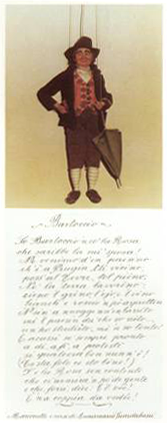Curiosity
The houses
Pian del Tevere farmhouse
The Pian del Tevere farmhouse is on land register in 1727. It is a typical and suggestive example of the big umbrian farmhouse at external staircase, in the middle of a large and prosperous estate, lands reclamed in the sixteenth century from the Benedictines monks. This religious order (whose motto was ora et labora, pray and work, protagonist of the land reclamation works and of an agrarian culture in different parts of Western Europe) realised big houses, as that one, for more and more numerous families, because of broad hands need. The farmer – Bartoccio is a character – is an head of a well organised farmer’s family, in which everyone contributes to produce wealth. At the beginning of the twentyth century, at Pian del Tevere resided a big family of twenty-four persons. The share-farming went out in 1965.
~ ~ ~
Casella della Barca‘s history
In the old days,were few bridges over the TiberRiver. But there were boats, flat boats that ferried from side to side. The peasants going to Perugia would cross the Tiber River on the ferryman’s (the barcarolo’s) large wooden boat (the barca). People used to pay him with country products, like eggs or chickens. The Miralduolo’s ferryman (the barcarolo) lived in a little house, not far from the river. It was Casella della Barca (which in the local dialect literally means the boat’s little house). He was waiting for the travelers on the edge of theTiberwhith the boat. He pulled it by hand, or with a horse or a donkey from the ground, running a tight rope between the two sides.
It was rare that they would pay the few cents, money, there were none. More often gave him a bit of wheat, eggs or products which, when dawn, they went on foot to sell at the vegetable market inPerugia. So the barcarolo also landed her meet, and sometimes exchanged something with those who passed. It was not an easy job, the river was not always good, with the current and eddies (bironi). In winter, when it was full, the river could carry off the boat! At Casella della Barca, the boat has worked until the ‘30s. The last barcaroli were called Montagna and there were three brothers, Francesco, Luigi and Costanzo. They called them “Bubù.” Then they came to live here sharecroppers Braccio and Argene Ceccacci, with his son Joseph and nephew Remo Giugliarelli.
Now, Casella della Barca – which was completely recovered in the ’50 – has been renovated with passionate attention to every detail, with the aim of making it beautiful and comfortable for our guests. Guests will enjoy the relaxing, peaceful and quiet atmosphere and will be sure to bring back home wonderful memories of their stay. Improving on the success of Pian del Tevere, we now have four glamorous apartments, measuring from 60 to 70 square meters, each of them decorated in a charming manner evoking the countryside and life along the river.
Two apartments are on the ground floor, and a further two are on the floor above. They have been named after old local dialect expressions. So Vent’i sopra (literally, the wind from over) means the north wind; Vent’i sotto (literally, the wind from below) means the south wind; la Vencara means the Osiery; la Merigge (from the latin meridiare, from meridies, midday) means, by opposite, the Shade.
“To save goat and cabbage”, read more below the page…

La grande casa colonica
Il restauro di Pian del Tevere
Pian del Tevere’s recovery is a rare and exemplary philological restoration of an Umbrian ancient farmhouse, carefully aimed at preserving perfectly entire the old farmhouse’s shapes, texture and atmosphere. Each particular detail has been carefully cared to avoid falsifications: from the wall’s unevenness, the roofs slopes softness and the small eaves, until the smallest details.
Doorways and windows are the original ones, with their almost invisible sills. Materials have been chosen according to the local housing traditions, from the finding of stones to the river pebbles, to the pure lime mortars. The rooms are the same as they once were, with walling and wood fireplaces, and the hand made floor tiles.
Modern comfort, however, is carefully assured by the presence in the building of absolutely new technological installations, well hidden in order not to be intrusive, with a special care to conceal the novelties, to hide pipes and ducts and to leave intact the external image of the big tiles roof.
~ ~ ~

Il Bartoccio, maschera di Perugia
Bartoccio
Bartoccio from Pian del Tevere, the Perugia’s “maschera”
Bartoccio from Pian del Tevere is the Perugia’s carnival maschera, as Harlequin is the maschera of Venice and Punchinello of Naples.
Bartoccio is a farmer who tolks local country rough dialect, who goes up to the town and brings every thing back at the primary substance of food, sex, life and death. He’s the burlesque type of the well-off rude countryman , rogue but ignorant, sapid but coarse.
His stock-character comes from the “commedia dell’arte” and represents the mirror into the town is looking at herself.
The maschera of Bartoccio comes from the seveteenth century and is the favourite reference of the dialect Perugia’s satirical literature.
Photo on the right: la marionetta (1960) di Bartoccio
(da Le Marionette di Anna M. Guardabassi, Volumnia Editrice, Perugia 1991).
~ ~ ~
“To save goat and cabbage”
About boats and ferrymen, do you know this saying “To save goat and cabbage” ?
The Italian expression “Save goat and cabbage”, which sounds “run with the hare and hunt with the hounds”, “you can’t have your cake and eat it”, or “manage to have it both ways” in English, (meaning to get out of an impasse, to have it both ways, to keep everybody happy),derives from a well-known problem included in Alcuin’s book.
“To save goat and cabbage” means a decision to safeguard the interests of two subjects that do not seem compatible. It seems like there’s no existing equivalent of the italian idiom “salvar capra e cavolo” in the English language. If is said about a ferryman who carried over the river a goat, a head of cabbage and a wolf, and the wolf did not eat the goat and the goat did not eat the cabbage. It is a riddle of a famous logician, with an ancient origin.
In the far 782 AD, Emperor Charlemagne called to his court in Aachen an English Benedictine monk, Alcuin from York (Flaccus Albinus, 730-804), who became Master of the great Schola Palatina. He was considered the most learned man of his time. In the book Propositiones ad acuendos juvenes (Problems to make witty young people) he picked puzzles and mathematical games. One of these – that was widespread in the Middle Ages and the Renaissance – is the Propositio de lupo et capra et fasciculo cauli (Problem of the wolf, the goat and the basket of cabbages):
Homo quidam debebat ultra fluvium transferre lupum et capram et fasciculum cauli, et non potuit aliam navem invenire, nisi quae duos tantum ex ipsis ferre valebat. Praeceptum itaque ei fuerat, ut omnia haec ultra omnino illaesa transferret. Dicat, qui potest, quomodo eos illaesos ultra transferre potuit.
SOLUTIO Simili namque tenore ducerem prius capram et dimitterem foris lupum et caulum. Tum deinde venirem lupumque ultra transferrem, lupoque foras misso rursus capram navi receptam ultra reducerem, capraque foras missa caulum transveherem ultra, atque iterum remigassem, capramque assumptam ultra duxissem. Sicque faciente facta erit remigatio salubris absque voragine lacerationis.
The ferryman had to carry across a river a wolf, a goat and a basket of cabbages, but the boat could only carry him in the company of one of the two beasts or him together with the single basket of cabbages. If he had left on one of the two banks of the wolf with the goat, they would have eaten. If he had left the goat and cabbage, that would eat them.
How did he do?
He completed the first trip with the goat. He left her on the other side and came back to take the cabbages. He ferried the cabbages and brought back the goat. Then he ferried the wolf, and left him on the other side with the cabbage. Finally he returned to take the goat and the fourth trip ended happily.
This post is also available in: Italian
Open all year round
Pian del Tevere
fraz. Miralduolo, 06089 Torgiano
Perugia . Umbria . ItalyTel. (+39) 075 988 9520
Cell. (+39) 340 763 2975
Telefonare entro le ore 20:00
info@piandeltevere.itPosizione GPS:
lat. 43.0573° N (43°3’26″ N)
long.12.433° E (12°25’59″ E)Torgiano is…
Link
Siamo su

Visita i nostri Social
About us










 English
English Italiano
Italiano